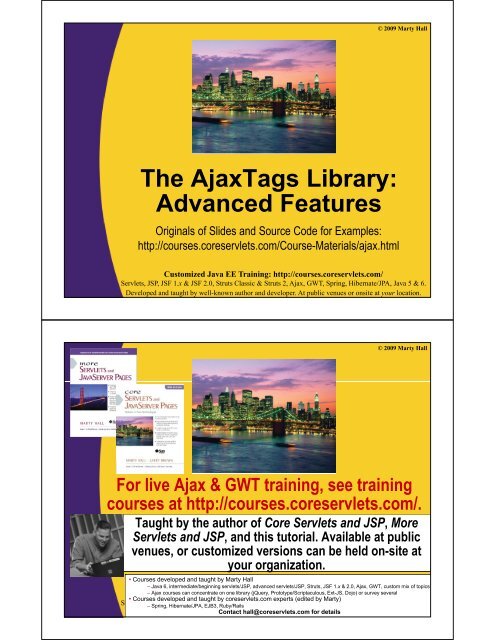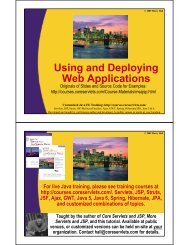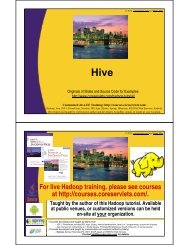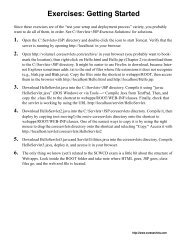The AjaxTags Library: Advanced Features - Custom Training ...
The AjaxTags Library: Advanced Features - Custom Training ...
The AjaxTags Library: Advanced Features - Custom Training ...
- No tags were found...
You also want an ePaper? Increase the reach of your titles
YUMPU automatically turns print PDFs into web optimized ePapers that Google loves.
Installation6• Several required JAR files– In Eclipse: WebContent/WEB-INF/lib– In deployed app: WEB-INF/lib– Download from http://ajaxtags.sourceforge.net/sourceforge • Prototype and Scriptaculous JS files– In Eclipse: WebContent/scripts– In deployed app: scripts– Download from http://script.aculo.us/• Simple installation– Download prebuilt starting-point project:ajaxtags-blank.zip• Download fromhttp://courses.coreservlets.com/Course-Materials/ajax.htmlBasic Setup: advanced.jsp(Covered in Previous Lecture)
Basic Idea10• Approach– indicator attribute designates section (usually div or span)that will be enabled while results are being loaded• It is disabled to start with, and disabled again when resultscome back• Often contains animated GIF showing progress• Main use– Gives user feedback when server-side resource takes along time• Note– You can reproduce indicator region in other places byusing Effect.Show from Scriptaculous• See later lectures on ScriptaculousJSP Exampleajax:autocomplete with indicatorProgramming language:Loading...11
Server-Side Codepublic class SlowLanguageCompleterLanguageCompletershown in previousextends LanguageCompleter {section@Overridepublic String getXmlContent(HttpServletRequest request,HttpServletResponseresponse)throws Exception {try { Thread.sleep(5000); } catch(Exception e) {}return(super.getXmlContent(request, response));}}12Results13
© 2009 Marty Hallajax:autocomplete withLinked Fields<strong>Custom</strong>ized Java EE <strong>Training</strong>: http://courses.coreservlets.com/Servlets, JSP, JSF 1.x & JSF 2.0, Struts Classic & Struts 2, Ajax, GWT, Spring, Hibernate/JPA, Java 5 & 6.Developed and taught by well-known author and developer. At public venues or onsite at your location.Basic Idea15• Approach– Server-side resource returns a list with names that aredifferent from values• xmlBuilder.addItem("name1", "value1");• In last section, names and values were the same– When name selected from dropdown, that name (value) put intothe textfield that has the dropdown– Names shown in dropdown box under main textfield– When a value is selected from dropdown, secondaryvalue placed into a different textfield• Main uses– When you have auxiliary information to display to user• E.g., g, show description when catalog ID selected– When you have associated values• E.g., word in another language
JSP Exampleajax:autocomplete with linked fieldsEnglish animal:Spanish animal:16Server-Side Codeimport javax.servlet.http.*;import org.ajaxtags.helpers. *;import org.ajaxtags.servlets.*;public class AnimalCompleter extends BaseAjaxServlet {@Overridepublic String getXmlContent(HttpServletRequest request,HttpServletResponse response)throws Exception {String animalPrefix =request.getParameter("englishAnimal");String animalList = makeAnimalList(animalPrefix);i lP return(animalList);}17
Server-Side Code (Continued)18}private static final String[][] animals ={ {"aardvark", "aardvark"},{"alligator", alligator , "cocodrilo"},{"antelope", "antílopo"}, {"baboon", "babuino"},{"bat", "murciélago"}, {"bear", "oso"}, {"cat", "gato"},{"camel", "camello"}, {"conch", "concha"}};private String makeAnimalList(String animalPrefix) {animalPrefix = animalPrefix.toUpperCase();AjaxXmlBuilder builder = new AjaxXmlBuilder();for(String[] animalPair: animals) {String englishAnimal = animalPair[0];String spanishAnimal = animalPair[1];if(englishAnimal.toUpperCase().startsWith(animalPrefix)) {builder.addItem(englishAnimal, spanishAnimal);}}return(builder.toString());}Results19
© 2009 Marty Hallajax:updateField withpostFunction<strong>Custom</strong>ized Java EE <strong>Training</strong>: http://courses.coreservlets.com/Servlets, JSP, JSF 1.x & JSF 2.0, Struts Classic & Struts 2, Ajax, GWT, Spring, Hibernate/JPA, Java 5 & 6.Developed and taught by well-known author and developer. At public venues or onsite at your location.Basic Idea• Approach– You list a regular JavaScript function as the value of thepostFunction or preFunction attribute• Almost all tags support postFunction and preFunction– <strong>The</strong> postFunction fires after the server-side resource isfinished– <strong>The</strong> preFunction fires just before the server-side resourceis called• Main uses– preFunction• To make an “I am working” message or image• Form field validation– postFunction• To highlight results or show a success message21
JSP Example (Continued)showConversionSuccess 24Server-Side Code• Same TemperatureConverter as in previoussection– Given a temperature in Fahrenheit, returns a list ofcorresponding temperatures in Celsius and Kelvin– Use of postFunction does not change how server-sideresource works25
Style Sheet Entries.temporaryMessage {border:2px solid blue;background-color:#eeffee;color:#009900;font-weight: bold;}26ResultsImmediately afterpressing button.Two seconds later.27
© 2009 Marty Hallajax:tabPanel witherrorFunction<strong>Custom</strong>ized Java EE <strong>Training</strong>: http://courses.coreservlets.com/Servlets, JSP, JSF 1.x & JSF 2.0, Struts Classic & Struts 2, Ajax, GWT, Spring, Hibernate/JPA, Java 5 & 6.Developed and taught by well-known author and developer. At public venues or onsite at your location.Basic Idea• Approach– You list a regular JavaScript function as the value of theerrorFunction attribute• Almost all <strong>AjaxTags</strong> tags support errorFunction– If server-side resource returns an HTTP status code otherthan 200, the errorFunction is triggered• Main uses– Error messages– Default values when server-side side resource is unavailable29
Script• scripts/errorFunction.jsfunction warn() {alert("Server error!\n\n" +}• error.jsp"Did you forget to specify\n" +"a default tab?");...<strong>Advanced</strong> <strong>AjaxTags</strong> Examples30JSP Example31ajax:tabPanelLargest Cities in Selected Northeast States...
Server-Side Code• Same PopulationFinder as in previoussection– Given a state and a city, returns the population– Use of errorFunction does not change how server-sidesideresource works32Results33
© 2009 Marty Hallajax:htmlContent withMultiple Triggers<strong>Custom</strong>ized Java EE <strong>Training</strong>: http://courses.coreservlets.com/Servlets, JSP, JSF 1.x & JSF 2.0, Struts Classic & Struts 2, Ajax, GWT, Spring, Hibernate/JPA, Java 5 & 6.Developed and taught by well-known author and developer. At public venues or onsite at your location.Basic Idea• Approach– In previous section, we used source to designate button• Gives the ID of the element that will trigger the action– If you use sourceClass instead, then any element thathas that CSS classname can be a trigger• <strong>The</strong> element must support onclick (push buttons, links,radio buttons, checkboxes, etc.)• Main use– Multiple ways of triggering an action35
JSP Exampleajax:htmlContent with Multiple TriggersState:Select StateMaryland...New YorkCity:Select CityShow PopulationShow Population36JSP Example (Continued)37
Server-Side Code• Same PopulationFinder as in previousexamples– Given a state and a city, returns the population– Type of trigger does not change how server-side side resourceworks38Results39
Summary• indicator attribute– Specifies region that displays temporarily while server-side side resourceruns• Returning a list for ajax:autocomplete with namesdifferent from values– Names get shown in the dropdown list– Name gets inserted in source textfield• I.e., the textfield that actually had dropdown list– Value gets inserted in target textfield• preFunction and postFunctions attributes– Arbitrary JavaScript that runs before or after server-side resource• errorFunction attribute– Function that runs when server has error• sourceClass attribute– Designates elements that trigger server-side resources40© 2009 Marty HallQuestions?<strong>Custom</strong>ized Java EE <strong>Training</strong>: http://courses.coreservlets.com/Servlets, JSP, JSF 1.x & JSF 2.0, Struts Classic & Struts 2, Ajax, GWT, Spring, Hibernate/JPA, Java 5 & 6.Developed and taught by well-known author and developer. At public venues or onsite at your location.

















